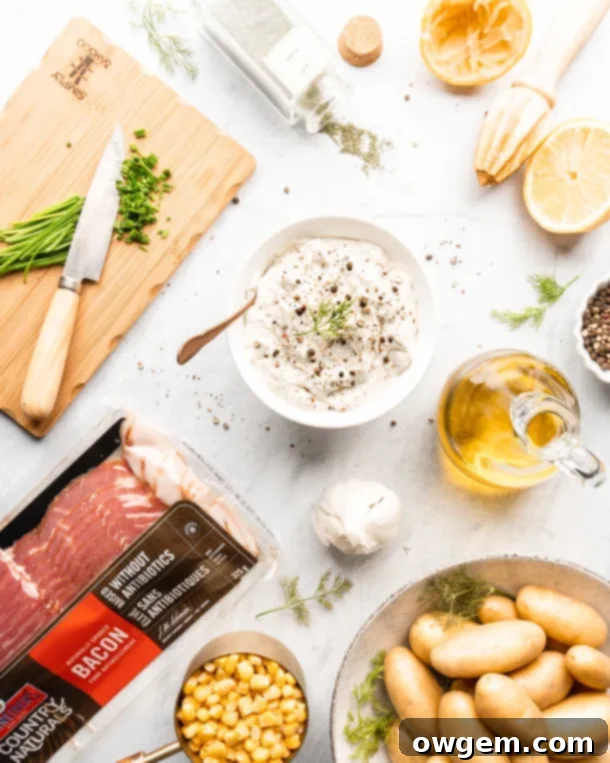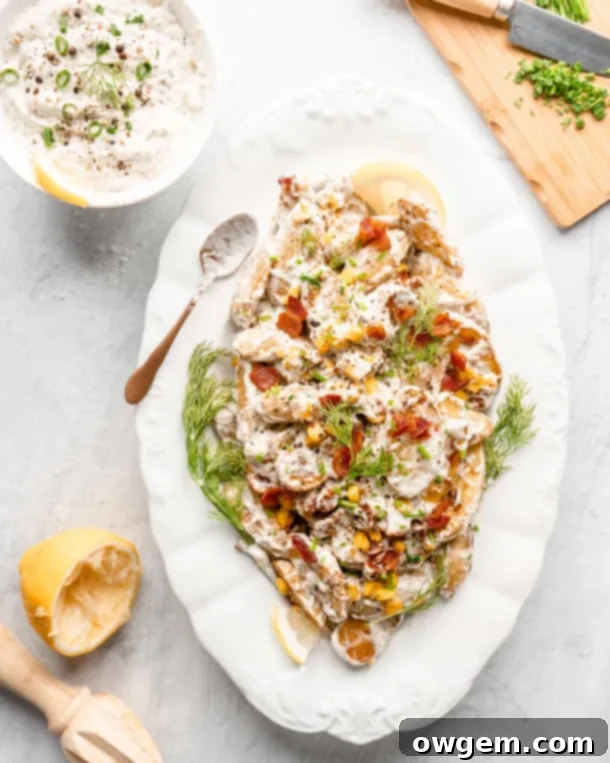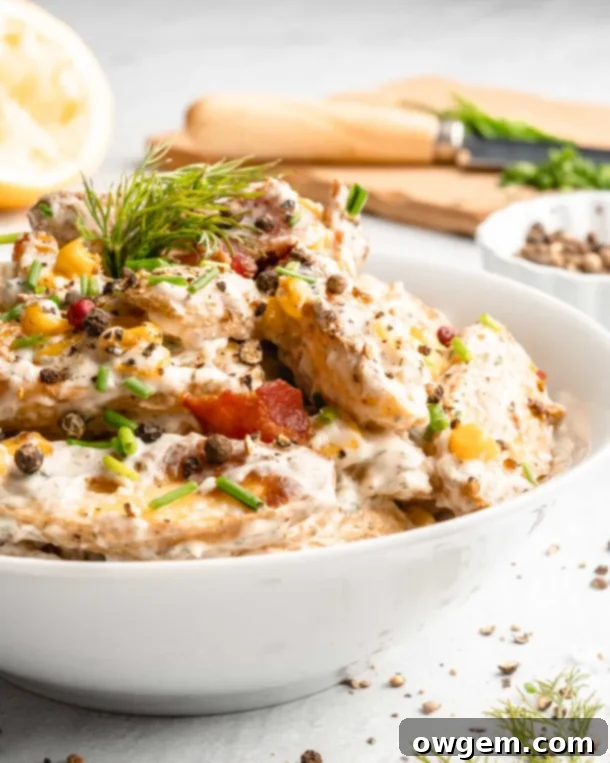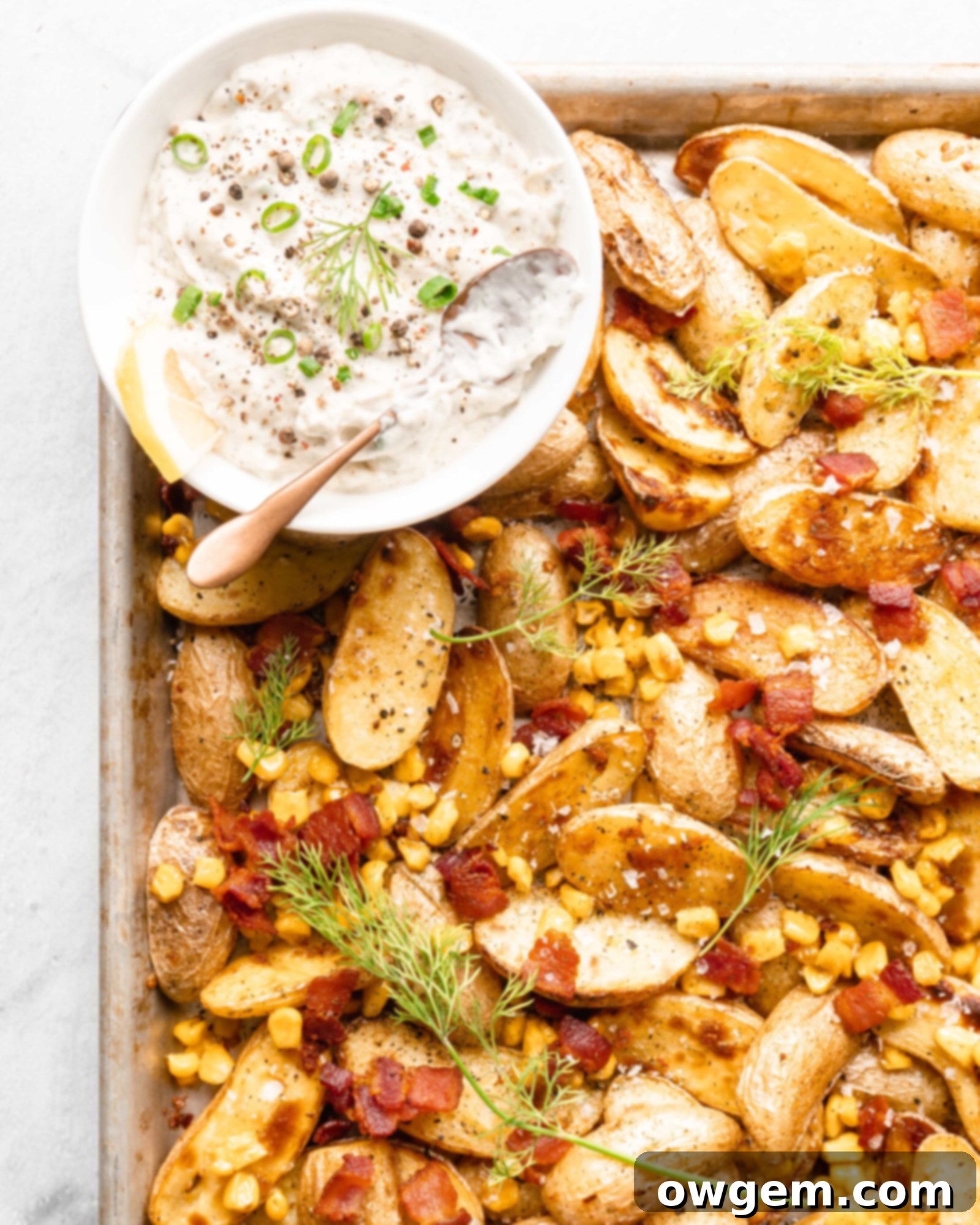Creamy Warm Potato Salad with Bacon & Roasted Corn: An Earls Copycat Recipe
Indulge in the ultimate comfort food experience with this incredibly creamy, bacon-filled, and delightfully warm potato salad. Directly inspired by the beloved original recipe from Earls Kitchen + Bar, this dish is guaranteed to be a spectacular addition to any meal, whether you’re hosting a barbecue, preparing a holiday feast, or simply craving a satisfying side. Our Earls copycat warm potato salad achieves a perfect harmony of vibrant flavors, balancing the zesty brightness of lemon and fresh chives with the savory crunch of bacon. The exquisite, velvety texture comes from a rich mayonnaise and sour cream base, beautifully complementing the buttery fingerling potatoes, while sweet, roasted corn adds an unexpected burst of flavor and a delightful textural contrast. Its unique warm serving temperature sets it apart from traditional cold potato salads, promising a delightful surprise for your taste buds.

The Earls Inspiration: A Culinary Journey to Recreate a Classic
This particular recipe holds a special place in my heart, born from a deep admiration for a classic dish served at Earls Kitchen + Bar, a popular chain restaurant well-known across Western Canada. For many years, their warm potato salad was a family favorite, a staple we eagerly ordered whenever we visited. However, like many beloved restaurant dishes, Earls eventually updated their recipe. While their current offering is still enjoyable, my heart remained loyal to their original rendition, particularly its use of tender, buttery fingerling potatoes. This recipe aims to revive that classic experience, capturing the essence of the warm potato salad we fell in love with.
I firmly believe that fingerling potatoes are the superior choice for this dish. Earls’ updated recipe now typically uses baby potatoes, which, while convenient, tend to develop a softer, creamier texture when cooked. This can sometimes lead to a “mushy” result if the potatoes are even slightly overcooked, losing the desirable structural integrity. Fingerling potatoes, on the other hand, beautifully retain their distinct shape and firmness even after roasting, providing a pleasant bite in the salad while still offering that delicious, inherent buttery flavor. Their elongated shape also makes them visually appealing. That being said, if fingerling potatoes are difficult to source in your area, baby potatoes are a perfectly acceptable substitute and will still yield a fantastic warm potato salad.

The quest to recreate this culinary gem began years ago, thanks to a serendipitous connection. My brother had a friend who worked as a line cook at an Earls location. My mom, a devoted fan of the warm potato salad, seized the opportunity and quite literally begged him for the recipe. To our delight, he obliged! However, as one might expect from a restaurant professional, the recipe he provided was scaled for commercial kitchen operations. I can’t recall the precise measurements, but the most memorable detail was the astounding 4 liters of mayonnaise required for a single batch!
My mom bravely attempted to scale down and recreate the dish a few times, but it never quite hit the mark. There were some minor inconsistencies in the provided recipe itself, coupled with the inherent challenge of accurately reducing such massive quantities of ingredients for home cooking. After a few well-intentioned but ultimately frustrating attempts, we eventually put our dream of homemade Earls warm potato salad on hold for many years. It wasn’t until a few weeks ago that I decided to pick up the torch, making it my personal mission to develop a foolproof, home-friendly version that perfectly captured the taste and texture of that original, cherished recipe.

The Art of Recipe Development: Trying, Testing, and Tweaking to Perfection
My journey to perfect this warm potato salad involved countless rounds of trying, testing, and tweaking every single element. This iterative process taught me valuable lessons about which ingredients were absolutely essential, what worked surprisingly well, and what simply missed the mark. The results of these experiments were crucial in refining this recipe to its current, delicious state.
Essential Ingredients and Smart Substitutions
- Fresh Lemon Juice is Non-Negotiable: This was perhaps the most critical discovery. Using freshly squeezed lemon juice is an absolute must. I experimented with bottled lemon juice, and unfortunately, it consistently detracted from the overall flavor profile. It introduced that unpleasant, slightly metallic and artificial taste that bottled lemon juice sometimes carries, completely throwing off the delicate balance of the salad. The bright, zesty notes of fresh lemon are indispensable for cutting through the richness and adding a vibrant lift to the dressing.
- Light Options are Fine: Interestingly, I found that substituting with light mayonnaise or light sour cream was perfectly acceptable. Unlike some recipes where low-fat alternatives can significantly compromise flavor or texture, in this warm potato salad, the robust combination of other ingredients and the warming process meant that the difference was negligible. This offers a great option for those looking to slightly reduce the calorie count without sacrificing taste.
- Dried Dill Wins Over Fresh: In a somewhat unexpected twist, I discovered that dried dill actually performed better than fresh dill in this particular recipe. While fresh herbs are often preferred, the concentrated flavor of dried dill seemed to meld more seamlessly into the creamy dressing, especially after resting. It provided a more consistent and deeper dill flavor throughout the salad, which I found superior to the sometimes overly herbaceous or quickly fading flavor of fresh dill in a warm context.
Perfecting the Textures and Flavors
- The Corn Conundrum: Determining the optimal time to add the corn was another key challenge. My initial attempt involved adding the frozen corn directly with the potatoes when they first went into the oven. This resulted in severely overcooked, dry, and rubbery corn. Next, I tried cooking or thawing the corn separately and tossing it in at the very end. While the corn was perfectly cooked, it failed to absorb any of the salad’s flavors and stood out too distinctly. The perfect solution, I found, was to add the corn halfway through the potato baking process. This allowed the corn to roast slightly, sweetening and softening just enough, while also integrating its flavor beautifully with the potatoes and the garlic oil without becoming dry. It achieved a sweet, tender crunch that was perfectly blended.
- The Secret Weapon: Bacon Fat: In my quest to replicate Earls’ unique smoky depth, I found a surprising but incredibly effective secret weapon: a small amount of the reserved bacon fat added directly to the dressing. This simple addition imparted a subtle, yet distinct smoky flavor that permeated the entire salad, truly enhancing its savory profile and creating a richness that was missing without it. It’s a small detail that makes a huge difference.
- The Magic of Garlic Oil: Lastly, I cannot overstate the importance of garlic-infused olive oil in this recipe. I experimented with regular olive oil, but the results were simply not the same. The garlic oil performs a crucial role by infusing the potatoes with a subtle, yet pervasive garlicky essence as they roast. This distinct flavor rounds out the entire dish, creating a more complex and satisfying taste experience. While regular olive oil with extra minced garlic will work in a pinch, I highly recommend seeking out garlic-infused olive oil for the authentic taste.

As a final, important aside based on my extensive testing, I’ve consistently found that the best results for this warm potato salad are achieved when you prepare the creamy dressing first. Allowing the dressing to rest in the refrigerator while the potatoes cook gives the flavors, especially the dried dill, ample time to blend and meld together harmoniously. This resting period allows the dill to fully hydrate and release its aromatic compounds, intensifying the overall depth and complexity of the dressing, ensuring every bite of potato salad is bursting with perfectly integrated flavor. It’s a small step that yields significant flavor dividends.


Warm Potato Salad: Earls Copycat Recipe
Pin
Rate
Ingredients
For the Warm Potato Salad
- 2 lbs Small Fingerling Potatoes,, washed and halved lengthwise
- 3 Garlic Cloves,, finely crushed or minced
- 1/4 cup Garlic-Infused Olive Oil, † (see notes for substitution)
- 1 cup Frozen Corn, no need to thaw
- 1/2 lb Bacon,, cut into small pieces †† (reserve fat)
- Entire Potato Salad Dressing, (prepared below)
- Salt & Freshly Ground Black Pepper,, to taste
- Fresh Chives, Green Onions, or Dried Dill, for garnish
For the Creamy Salad Dressing
- 2/3 cup Mayonnaise, full-fat or light
- 1/2 cup Sour Cream, full-fat or light
- 1/4 cup Finely Grated Parmigiano Reggiano, for a cheesy depth
- 2 tbsp Reserved Bacon Fat, for smoky flavor
- 1 tbsp Freshly Squeezed Lemon Juice, vital for brightness
- 1 tsp Dried Dill, for classic flavor
- 1 tsp Minced Green Onion, or finely chopped chives
- Salt & Freshly Ground Black Pepper,, to taste
Instructions
Preparing the Warm Potato Salad
-
In a large frying pan, cook the bacon pieces over medium-high heat until they are beautifully golden brown and delightfully crispy. Remove the cooked bacon from the pan with a slotted spoon and set it aside on a paper towel-lined plate to drain. Carefully reserve 2 tablespoons of the rendered bacon fat for the salad dressing.
-
Preheat your oven to 425°F (220°C). While the oven preheats, take a large mixing bowl and combine the halved fingerling potatoes and crushed garlic. Drizzle with most of the garlic-infused olive oil, reserving about 1 tablespoon for the corn later. Toss everything together thoroughly, ensuring the potatoes are evenly coated, then season generously with salt and freshly ground black pepper. Spread the seasoned potatoes in a single layer onto a large baking sheet and bake for 20 minutes.
-
After the potatoes have been baking for 20 minutes, remove the baking sheet from the oven. In a small bowl, toss the frozen corn with the remaining 1 tablespoon of garlic oil. Add the seasoned corn to the baking sheet with the potatoes, spreading it out evenly. Return the baking sheet to the oven and continue baking for an additional 25 minutes, or until the potatoes are tender and lightly browned, and the corn is slightly roasted.
-
Once baked, carefully transfer the warm potatoes and corn into a large serving bowl. Pour the prepared salad dressing over the top and gently toss until all the potatoes and corn are thoroughly coated. Fold in the crispy bacon pieces. Garnish generously with fresh chives, green onions, or extra dried dill, and adjust seasoning with additional salt and pepper to taste. Serve immediately while warm.
Preparing the Creamy Salad Dressing
-
In a medium-sized bowl, combine all the ingredients for the salad dressing: mayonnaise, sour cream, finely grated Parmigiano Reggiano, reserved bacon fat, freshly squeezed lemon juice, dried dill, minced green onion, and salt and pepper. Whisk vigorously until all ingredients are well combined and the dressing is smooth and creamy. Set aside in the refrigerator until needed, allowing the flavors to meld and deepen. This dressing can be prepared up to a day in advance for optimal flavor.
Notes
†† Bacon & Bacon Fat: The smoky flavor from the reserved bacon fat is a key component of this dressing, adding incredible depth. Ensure you reserve precisely 2 tablespoons after frying your bacon pieces. If you prefer, you can use a plant-based bacon substitute and omit the bacon fat from the dressing, adjusting other seasonings to taste.
Source: Inspired by Earls
